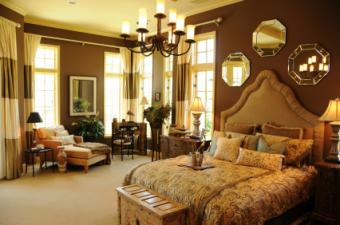
Instead of sticking to solid color window panels, make your mark with drapery patterns that pop. The addition of simple or ornate drapery patterns will infuse a room with rhythm.
Drapery Basics
Drapery panels are a classic way to dress any window. These long curtains typically feature enough fabric to cover the entire window expanse. Some lengthy drapes go past the windowsill to skim above or puddle on the floor. Ready-made drapes can be found in standard lengths between 63 to 95 inches, but some retailers do carry longer panels in many drapery patterns. If you need a longer length, then custom-made drapes are the way to go.
Most draperies can be hung on wooden or metal poles using rings, or they can also be mounted on standard curtain rods if there is a rod pocket sewn in. Panels with tab tops or grommets will slide directly onto a rod without the need for rings. For a different approach, drapes can be tied or hung from a set of medallions or hooks that frame the window. Stationary side panels require less fabric and are a great option when you don't need to draw the curtains all the way across the windows.
Striped Draperies

To make a room or set of windows look taller, consider putting up striped drapery patterns. The addition of stripes will create vertical lines that draw the eye upwards. This is a bonus for rooms with low ceilings. Striped drapes can be modern, traditional, or whimsical depending on the fabric colors chosen. Horizontal striped draperies are being used more often, especially in contemporary style rooms. The horizontal lines will make a room look wider and less narrow.
Silk Draperies
Silk is a very popular fabric for use in drapery panels. When using real silk drapes, it's important to include a lining which will decrease sunlight damage. Silk naturally fades over time, so a lining along with an interlining will help slow this down. The newest trend in silk fabrics is embroidered designs with botanical themes. These delicate embroidered drapery patterns feature curving vines with leaves, flowers, or other embellishments. If you are working with a tight budget, choose a beautiful faux silk which will cost less and also not fade as easily as natural silk.
Other Drapery Patterns
There are numerous drapery patterns available to suit every decorating style and room design. Here is a list of common fabrics that make wonderful draperies:

- Plaid and Checks - perfect for traditional and European room décor.
- Paisley - swirling teardrop patterns which fit well with Old World interiors. Large scale graphic paisleys have a funky retro feel.
- Damask - ornamental woven fabric with floral, animal, or decorative themes.
- Floral - this can have a wide range of looks from cottage to tropical to country.
- Lace - a timeless feminine design.
- Contemporary patterns - this can include dots, squares, and abstract drapery patterns.
- Toile - ideal for French Country interiors.
- Velvet Burnout - a sumptuous fabric which adds drama and richness.
- Natural Textures - rustic fabrics such as burlap and linen.
- Sheers - subtle embroidered or printed patterns on sheer fabric will filter light beautifully.







